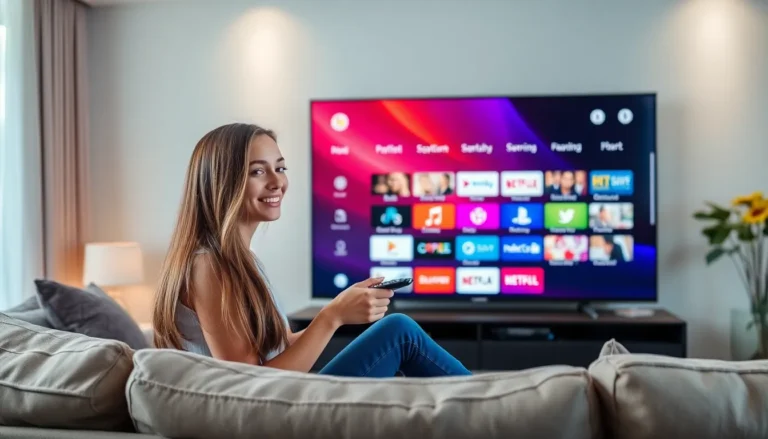In a world where financial literacy feels like trying to understand quantum physics, personal finance apps swoop in like superheroes ready to save the day. They turn the daunting task of budgeting, saving, and investing into a user-friendly experience that even your grandma could master—assuming she can figure out her smartphone.
These apps aren’t just tools; they’re like having a financial advisor in your pocket, minus the hefty fees and awkward small talk. With a few taps, anyone can track expenses, set goals, and maybe even learn the difference between a 401(k) and a savings account. So why not embrace the tech revolution? Your future self will thank you, and who doesn’t want to impress their friends with their newfound financial savvy?
Table of Contents
ToggleOverview Of Personal Finance Apps
Personal finance apps offer users an efficient way to manage financial tasks. These tools help in budgeting, saving, and investing, making financial planning accessible. Many apps allow users to track expenses in real-time, enhancing awareness of spending habits. A selection of features—like goal setting and personalized insights—empowers users to achieve their financial objectives.
Popular personal finance apps include Mint, You Need a Budget, and PocketGuard. Each app offers unique features tailored to different user needs. Mint synchronizes with bank accounts to categorize expenses automatically. You Need a Budget emphasizes proactive budgeting based on income and priorities. PocketGuard simplifies the budgeting process by showing how much disposable income is available.
Users benefit from secure data storage and advanced encryption within these platforms. Security measures ensure that sensitive financial information remains protected. Seamless updates keep apps functional and relevant, adapting to changing financial trends. Many personal finance apps also provide educational resources, enhancing users’ financial literacy.
Adopting personal finance apps leads to improved financial habits. Users frequently report increased savings and reduced debt through diligent tracking. Embracing technology fosters accountability and engagement with personal finances. Whether managing day-to-day expenses or planning for long-term goals, these apps serve as essential tools in achieving financial well-being.
Key Features To Look For
Choosing the right personal finance app means considering several important features. Focusing on these attributes enhances user experience and outcomes.
Budgeting Tools
Robust budgeting tools enable users to create and manage budgets effectively. Simple interfaces allow users to allocate funds to categories like groceries or entertainment seamlessly. Several apps provide templates or customizable options for unique financial situations. Automated notifications alert users when they approach budget limits, fostering better financial discipline. Integrating historical spending data helps users establish more accurate future budgets.
Expense Tracking
Detailed expense tracking unveils insights into spending habits. Users should find apps that categorize expenses automatically, simplifying the process. Real-time updates keep users informed about where their money goes daily. Customizable reporting features offer users the ability to see their expenses over various timeframes. Analytics can reveal trends and highlight potential savings opportunities, guiding smarter financial decisions.
Investment Management
Effective investment management tools empower users to grow their wealth confidently. Apps that provide portfolio tracking allow users to monitor asset performance and allocations easily. Comprehensive educational resources teach users about investment strategies and market trends. Notifications about market changes and opportunities support timely investment decisions. Some apps even offer automated investment options, making it easier for users to invest consistently with minimal effort.
Popular Personal Finance Apps
Many personal finance apps help users manage their financial lives efficiently. These tools provide various features tailored to individual needs.
App 1: Mint
Mint stands out for its comprehensive budgeting capabilities. Users can connect bank accounts and credit cards to monitor transactions in real-time. This app categorizes spending automatically, offering a clear view of spending habits. Features like bill reminders help avoid late fees. Mint also provides personalized insights based on financial goals. With its robust security measures, sensitive data remains protected.
App 2: YNAB
You Need a Budget, or YNAB, focuses on proactive budgeting. The app encourages users to allocate every dollar to specific expenses or savings goals. Features like real-time tracking enable users to adjust spending as needed. YNAB’s educational resources empower users to improve their budgeting skills. Users can access goal-setting tools that help visualize progress. The mobile-friendly interface allows easy management from anywhere, fostering engagement with finances.
App 3: Personal Capital
Personal Capital offers investment management alongside budgeting tools. Users can track their net worth and analyze spending with detailed reports. This app emphasizes retirement planning, providing projection tools to strategize for the future. Personal Capital’s dashboard offers a comprehensive financial overview, making investment tracking straightforward. Users benefit from portfolio analysis features designed to optimize investment choices. Security protocols ensure that personal financial information remains confidential.
Benefits Of Using Personal Finance Apps
Personal finance apps simplify financial management for users. They provide real-time tracking of expenses, making it easy to monitor spending habits. Budgeting capabilities in these apps help users allocate funds efficiently.
Users benefit from features like automated bill reminders, which reduce the risk of late payments. Customizable reports offer insights into spending patterns, encouraging smarter financial decisions. Educational resources within the apps further enhance users’ understanding of personal finance concepts.
Security measures protect sensitive information, creating a secure environment for financial management. Coordination with bank accounts and credit cards allows users to consolidate financial data in one place. Overall, these tools foster improved budgeting skills through proactive money management.
Additionally, investment tracking features in apps like Personal Capital help users analyze their portfolios and plan for retirement. These capabilities make users more aware of their financial health and future opportunities. As a result, individuals adopting personal finance apps often experience increased savings and reduced debt levels.
By utilizing these apps, users cultivate accountability and engagement with their finances, significantly improving their financial literacy. Thus, personal finance apps serve as indispensable tools for anyone seeking to enhance their financial well-being.
Potential Drawbacks
Personal finance apps, while beneficial, come with several drawbacks that users should consider. Privacy concerns often arise due to the sensitive nature of financial data. Apps typically require access to bank accounts and personal information, increasing the risk of data breaches or misuse.
Another issue involves reliance on technology. Users may find themselves dependent on their devices for financial tracking, which can lead to disconnect from their spending habits. Some individuals struggle to manage finances without app support, diminishing their overall financial literacy.
Limited functionality can also pose a challenge. Not all personal finance apps offer comprehensive features, leaving certain financial aspects unaddressed. For example, budgeting tools in one app might not align with investment tracking in another, creating a fragmented financial overview.
Inconsistent user experience varies across different platforms. Users may encounter bugs or inconsistencies that disrupt their experience. Technical issues can lead to frustration and reduced engagement with the app.
Costs sometimes come as unexpected drawbacks. While many apps offer free versions, premium features often require monthly fees. Users may question whether paying for these features provides sufficient value compared to traditional financial methods.
Lastly, the potential for oversimplification exists. Apps may offer basic advice, yet personal financial situations rarely fit into a one-size-fits-all solution. Users must be cautious about following app recommendations without considering their unique circumstances.
While personal finance apps enhance financial management, users should remain aware of the potential drawbacks to ensure a balanced approach to their financial journey.
Conclusion
Personal finance apps have transformed the way individuals manage their money by making financial literacy accessible and engaging. These tools empower users to take control of their finances through budgeting tracking and investment management. While they offer significant benefits like real-time tracking and automated reminders, it’s crucial to remain mindful of potential drawbacks such as privacy concerns and over-reliance on technology.
By carefully selecting the right app and maintaining a balanced approach to financial management users can cultivate better habits and achieve their financial goals. Embracing these digital tools can lead to improved savings reduced debt and a deeper understanding of one’s financial health. Ultimately personal finance apps serve as valuable allies in the journey toward financial well-being.







